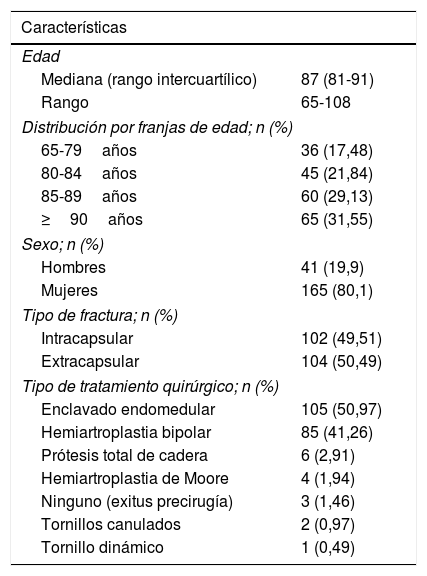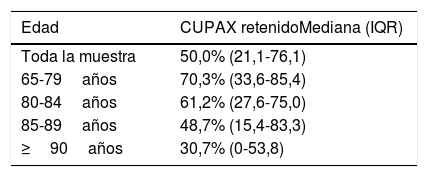La fractura osteoporótica de cadera es una enfermedad relevante por su prevalencia e impacto social y sanitario. El objetivo de este estudio es explorar la validez predictiva del cuestionario CUPAX sobre la mortalidad, el lugar de residencia y la funcionalidad posfractura.
Materiales y métodosEstudio observacional prospectivo. Se incluyeron 206 pacientes mayores de 65 años ingresados tras una fractura de cadera. Se recogió la puntuación del cuestionario CUPAX prefractura y al año, y el lugar de residencia y la supervivencia al alta hospitalaria y a los 6 y 12 meses. El análisis estadístico se ha realizado con los programas SAS® 9.4 y Stata® 13.1.
ResultadosLa edad mediana de la muestra fue 87 años (80,1% mujeres). La tasa de mortalidad intrahospitalaria y al año fue del 5,8% y 19,1%, respectivamente. La mayoría de los pacientes procedían de su domicilio (71,4%), y el destino al alta más frecuente fue un centro sociosanitario (48,2%). El porcentaje de retención del nivel funcional previo en el total de la muestra fue del 50%, siendo mayor en los pacientes más jóvenes. El área bajo la curva ROC para la mortalidad al año fue 0,697 (IC 95%: 0,626-0,760) y para el destino al alta de los pacientes procedentes del domicilio 0,659 (IC 95%: 0,576-0,741). La valoración de la retención funcional al año permite identificar 3 grupos de pacientes en función del valor del CUPAX prefractura.
ConclusionesEstos hallazgos apoyan la utilidad clínica del cuestionario CUPAX como herramienta funcional predictiva en pacientes ancianos afectos de fractura de cadera.
Osteoporotic hip fracture is a relevant pathology due to its prevalence and social and health impact. The aim of this study is to explore the predictive validity of the CUPAX questionnaire on mortality, place of residence and post-fracture functionality.
Materials and methodsProspective observational study. Two hundred and six patients older than 65 years were included, admitted after a hip fracture. The CUPAX questionnaire score was collected before fracture and one year later, and the place of residence and survival at hospital discharge, and after 6 and 12 months. The statistical analysis was carried out with the SAS® 9.4 and Stata® 13.1 programmes.
ResultsThe median age of the sample was 87.0 years (80.1% women). The in-hospital and one-year mortality rate were 5.8% and 19.1%, respectively. Most of the patients were admitted from home (71.4%), and the most frequent discharge destination was a social health centre (48.2%). The percentage of retention of previous functional level in the total sample was 50%, being higher in the younger patients. The area under the curve ROC for mortality one year later was .697 (95% CI .626-.760) and .659 (95% CI .576-.741) for the discharge destination of patients admitted from home. Evaluation of functional retention one year after the fracture, identified three groups of patients based on the pre-fracture CUPAX value.
ConclusionsThese findings support the clinical utility of the CUPAX questionnaire as a predictive functional tool in elderly patients with hip fracture.














